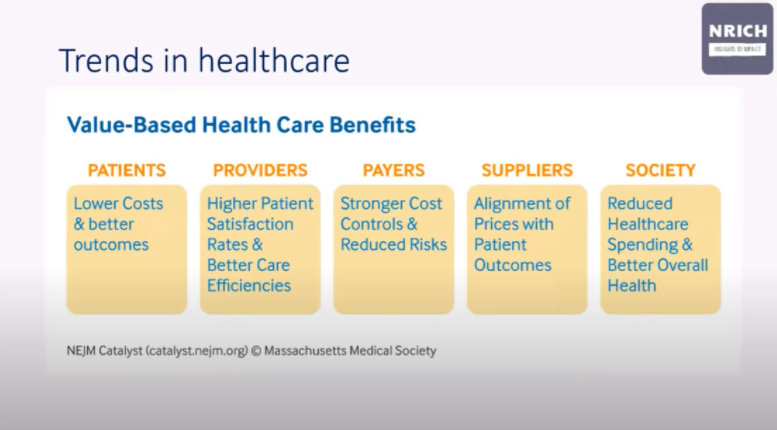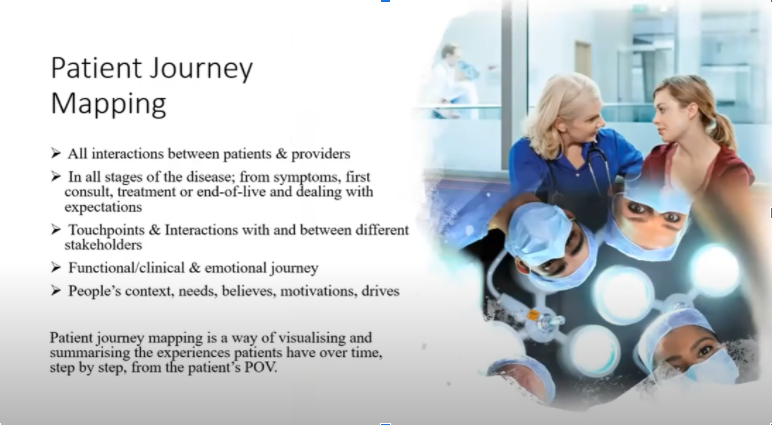This article is based on the patient journey mapping talk by Anneke Rijk at our recent event from the healthcare journey mapping series. Anneke Rijk is a market research and consumer insights professional who worked for 13 years at Nutricia, a manufacturer of medical nutrition products, devices, and services. In 2020, she founded NRICH Insights to Impact, a consulting company.
Introduction
The healthcare industry has undergone significant changes over recent years. Today’s healthcare systems are under economic pressure caused by social and demographic changes like e-health and connected data, the growing number of chronically ill people, and increased patient participation in treatment.
In the healthcare and pharma industry itself, there’s a shift from traditional clinical trials towards more real-world evidence to measure what a clinical trial does to patients, how they experience it, a treatment, a new drug, or a new service.
With all this happening, there is an urge for the healthcare industry to better understand patients and their journey. What are their concerns, priorities, needs, and their expectations of the consultation (or the discussion) they're having? What influence might they have on treatment-related decisions and the quality of life? What does it mean to live with the disease?
Journey mapping is a great way to capture and visualize all the available knowledge, data, and insights about the current journey and then take it from there.
In this article, you won’t find the theory that you can read in books or on the Internet but some pragmatic, hands-on tips, as well as dos and don’ts from Anneke’s experience.
Contents
Trends in healthcare
In the healthcare setting, even people who don't follow healthcare advancements and innovations have some idea of the trends. However, when it comes to customer experience trends, most doctors, service providers, and stakeholders don't think of themselves and their work in the context of customer service. However, patients have started thinking of themselves not as patients but as customers.
There are some healthcare trends like the ones that were indicated previously (e-health, connected data, smart technology, etc.). Another big trend worth mentioning is the transition from volume-based to value-based healthcare.
Value-based healthcare offers many benefits to all stakeholders involved and, in the end, delivers better overall health at reduced healthcare spending.

This model puts patients first because it's about their lives, their treatment, and their health. It starts with really understanding a patient's journey throughout and understanding the human being, the person, their context, and their life.
Patient journey mapping
Patient journey mapping is a great tool to capture all these things. Check out the slide below to learn what patient journey mapping is and what such maps typically include.

Patient journey maps cover touchpoints and interactions with and between different stakeholders in the healthcare setting. It's a complex environment. There can be involved insurance companies and different kinds of specialists who work in various hospitals or centers.
It's also about mapping the functional, the clinical journey, and the emotional one. An emotional journey is what gives you a real holistic view of the person going through this journey. It gives you the answer to the following questions: What are their experiences? How do they live through this journey? What is the context? What about their families and their relatives? What about the personal situation?
Capturing these people’s experiences and their points of view helps healthcare and pharma companies think about making their lives better and improving their experience.
How to prepare
How to prepare for creating a patient journey map or doing a workshop? Keep these things in mind to do everything right:
- Know your stuff. To get started with patient journey mapping, you can read books about how to plan and schedule a journey mapping workshop, listen to expert podcasts, or even hire an expert if you’re not confident enough to start mapping on your own.
- Involve a multidisciplinary team. Journey mapping goes beyond the marketing team only. You need to have everybody's knowledge and everybody's input in these workshops. By inviting those people to join and be part of this journey, you also drive engagement and interest.
- Spend enough time on the business question or challenge you want to solve. Align with everyone within your multidisciplinary team and stakeholders on the scope of your patient journey map you are going to build, which patients are the target group, and which journey stages you will map out.

- Do some research before you start mapping. Before you start working on a patient journey map, ask the multidisciplinary team to search for all available facts and information within a company and within departments. You’ll be surprised by how much useful information and unknown facts they will bring to the workshop.
- Be prepared to tackle and challenge assumptions and fight with strong opinions. There can be people who are so convinced of their beliefs, findings, or assumptions that it’ll be quite hard to tackle them and challenge them.
- Involve your target group at every step. Talk to patients, healthcare professionals, caregivers, family and relatives, and anyone else who is relevant to this journey.
- Include details. Be sure to capture what the person is doing at a detailed level so that you can do something with the data. Capture what they’re doing at each stage of their journey and what they are thinking and feeling at that moment.
- Find your path. Try different journey mapping frameworks, tools, or services to find the one that works best for you and your company and put it to use.
How to make the journey memorable

There are some sure-fire tips to make your patient journey mapping project memorable.
- Engage internal stakeholders and senior management from the very beginning and at every stage of the project. Invite them at the start and keep them informed and updated.
- Take into account stakeholder and business needs. Anything you do from the patient journey mapping workshop itself until finding the solutions and implementing them needs to fit these needs.
- Break silos in the organization by bringing the multidisciplinary team together and encouraging these people to share their knowledge and work together towards a common goal.
- Always check assumptions to make sure that they’re factually correct.
- Map out the emotional journey as well. Emotional journeys will help you better understand what people go through.
“We were building a journey map for children with epilepsy. And we thought that we knew how the parents would feel after they visited the specialist. We thought that they were relieved because they finally had the diagnosis. However, when we talked to the parents, we found out that they were devastated because they didn't know what to expect. So it's not about pretending that you know what others feel. It's about talking to them, asking them questions, doing research, and capturing the emotions they feel and their experience.”
- Make sure that every solution you have fits the organization's mission and purpose.
- Remember about the regulatory framework. The best thing you can do is ask your colleagues involved in the regulatory staff to become part of the multidisciplinary team working on the map. This way, you’ll minimize or eliminate potential legal problems.
- Find a technology partner to build things together. If you don’t have all the technology you need in-house, go outside and look for a technology partner to work with.
- Building a business case to get funding can be challenging. In the context of patient journey mapping, it’s not always about developing a product or service to get more money or sell more products. It’s about improving someone’s care or developing a service that will enhance their emotional state. You’ll have to think about a different way of selling your story and building a business case.
- Engage patient organizations. Patient organizations are growing in prominence, and collaborating with them can give your project a boost.
- Do not treat it as a one-off exercise. You create a map not to put it on the wall and forget about it but to act on it. It’s essential to keep the map alive, look at it regularly, improve it, and make sure it’s validated. You can use it as a foundation for a more detailed map that will cover specific stages or take it to another team that works in another disease area to show them the advantages of having it.
- Map the caregivers’ journey, as well. Map the caregiver's journey because it also helps to understand the patient's journey and adds another layer of insight.
- Think of accountability at the very start, during your work on the map, and when you're thinking about building solutions.
- Build a customer-centric culture and mentality in your organization, as everyone in it is part of the patient experience.
Wrapping up
The transition from volume-based healthcare to value-based healthcare urges healthcare providers to start putting patients first. Doing that is impossible without understanding what patients are going through and what they experience at every stage of their journeys.
Patient journey mapping can help visualize and summarize these experiences. In this article, you found some hands-on tips to succeed with your first project.
Bonus: the recording
You can watch the full recording below.





